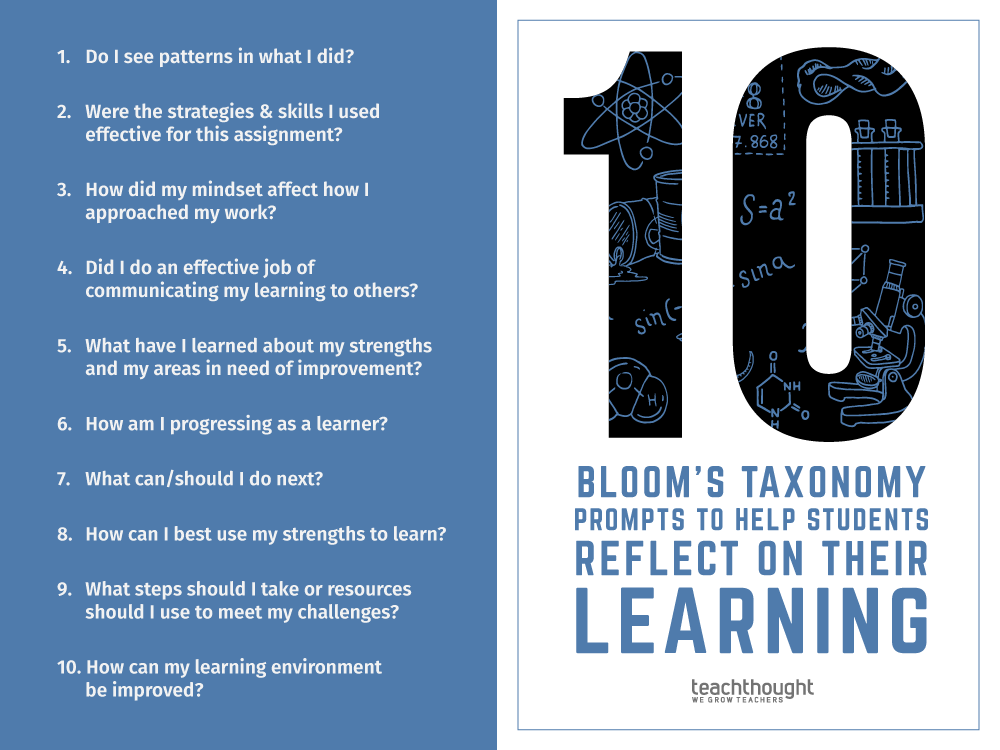
10 Metacognitive Prompts To Help Students Reflect On Their Learning
by TeachThought Staff & Peter Pappas
It’s well-established that reflection is critical in the learning process.
While it sounds formal, ‘reflection’ simply means to ‘think again’ about something that happened. Reflection is a natural part of learning and in many cases doesn’t even need to be ‘promoted.” Given time and collaboration, students (and adults) tend to talk about experiences and learn from that kind of reflection.
Why this is true is a deeper diver, but it’s clear that when the brain ‘experiences’ something, it doesn’t necessarily ‘see it’ accurately. That is, perspective, mindset, background knowledge, emotional well-being, setting, social context, and more all affect now just ‘how’ we experience an event but even what parts of the event we even experience–or remember–at all. Consider watching a movie for the first time.
Because you don’t know what’s going to happen, your brain ‘experiences’ the story with anticipation and pattern-making, trying to relate to the characters while ‘following’ what might happen. Watch the movie a second time, however, and you’ll ‘see it’ completely differently.
It’s the same story and the same brain experienced in two very different ways.
Metacognition In The Learning Process
How can metacognitive prompts be used to promote reflection in learning?
In the past, we’ve offered 20 Types Of Journals That Help Students Think, including:
Question Journal: This type of journal is focused on inquiry–the asking and refinement of questions. They can be answered or merely ‘wondered about.’ The big idea here is students asking and improving their own questions. The QFT Strategy could be useful here.
Metacognitive Journal: A journal focused on thinking about thinking. In a Metacognitive Journal, students are writing about their thinking–their tendencies, changes in their thinking over time, cognitive blind spots, etc.
In What is Bloom’s Taxonomy?, we also explained that “Bloom’s Taxonomy is a hierarchical ordering of cognitive skills that can, among countless other uses, help teachers teach and students learn.” It doesn’t take a huge leap to see how this can be used to promote thinking about past learning experiences (reflection), so we’ve gathered a small collection of those prompts specifically focused on student thinking and metacognition.
You can read 38 Prompts Merging Reflective Thinking With Bloom’s Taxonomy for the full collection of questions and prompts. This post is simply a slightly revised and updated excerpt from that post that focuses on metacognitive prompts based, in large part, on Bloom’s Taxonomy.
The hope is that these questions might help students reflect on the learning experience, especially as it relates to their own thinking and cognitive behaviors.
10 Metacognitive Prompts To Help Students Reflect On Their Learning
1. Do I see patterns in what I did?
2. Were the strategies and skills I used effective for this assignment?
3. How did my mindset affect how I approached my work?
4. Did I do an effective job of communicating with others before, during, or after learning?
5. What have I learned about my strengths and my areas in need of improvement?
6. How am I progressing as a learner?
7. What can/should I do next?
8. How can I best use my strengths to learn?
9. What steps should I take or resources should I use to meet my challenges?
10. How can my learning environment be improved?
